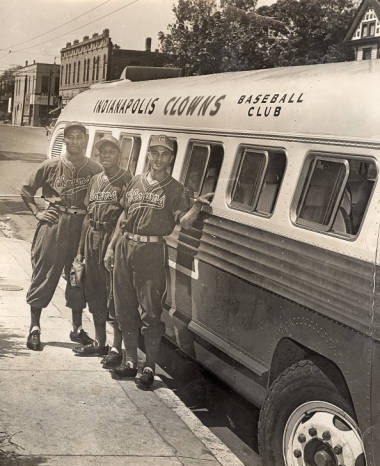
Indianapolis Clown players stand by the team bus. They are Manuel Godines, Reinaldo Verde and Andres Mesa (L to R). 1947. Photo courtesy of the Indiana Historical Society.
The most famous Black league team to play in Indianapolis was the Indianapolis Clowns of the Negro American League. In 1943, an Indianapolis league joined a barnstorming outfit based in Miami known nationwide as the Ethiopian Clowns. It was a team as devoted to showmanship and on field clowning as to serious diamond play. It was a baseball equivalent of basketball’s immensely popular Harlem Globetrotters.
To bolster sagging gates, some teams added novel attractions to their games, and the Indianapolis Clowns were the ultimate champions of such burlesque baseball, often wearing grass skirts, painting their bodies to appear as African cannibals, and donning names such as “Selassie,” “Mofike,” Wahoo,” and even “Tarzan.”
Once admitted to Negro American League play, the Indianapolis Clowns toned down these pranks and blatant showmanship, though they made the club one of the most popular in the circuit with fans, especially during barnstorming exhibition games in front of largely white crowds. Predictably, many Negro League players themselves deeply resented the comic image of the Indianapolis team.
Some remarkable players performed over the years for the Indianapolis Clowns, including future home run king Henry “Hammerin’ Hank” Aaron, who made his Negro League debut with Indianapolis as a teenage shortstop in 1951 and 1952. Aaron missed regular Negro American League play; his debut came the season after the league suspended action and resumed a nationwide schedule of barnstorming. By 1953, however, Aaron was part of the Milwaukee Braves and soon desegregating the South Atlantic League on his road to big league stardom.
Meanwhile, the Clowns were further spicing their roster with a female second basewoman named Toni Stone, a player talented enough to bat .243 while appearing in approximately 50 of the Clowns’ 175 games that season.
Throughout their earlier eight-season tenure in the organized Negro American League, the Clowns boasted some moderately successful teams as well—winning the Eastern Division title the final season of 1950 (when no championship playoff between Eastern and Western divisional winners was held). They finished as league runner-up in both halves of a single-division split season during their second league campaign of 1944. The team actually divided time between Cincinnati and Indianapolis during the 1943-1945 seasons. Following7 the demise of the Negro League structure in 1950, the Indianapolis Clowns continued their barnstorming show across the nation for another two decades, only disbanding in the early 1970s.
Peter C. Bjarkman, Society for American Baseball Research

